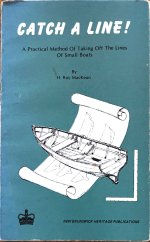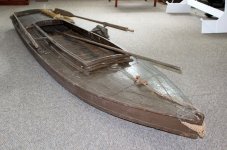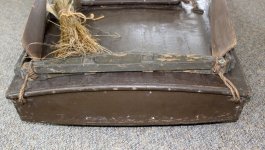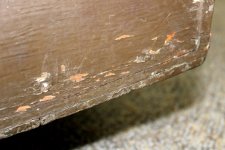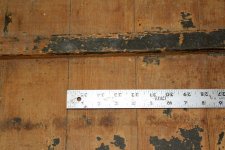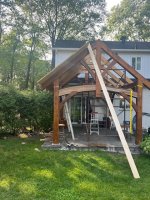Steve Sanford
Well-known member
Good morning, All~
Dax Hinton recently asked me how difficult it would be to draw plans to build an existing gunning boat - specifically the sweet "Midwest Gunning Skiffs" (my term) he found recently in a museum (?).
The short answer, I suppose, is very difficult. It is usually the province of trained and licensed marine architects. On the other hand, I have done it - and I imagine there are others here on the site that have done it as well. So, I will give an overview of the process and some random thoughts. I would encourage anyone to make the attempt.
I would also encourage anyone to read all of John Garner's books. This one has a lengthy chapter on Four Canoes - that would be a good starting point for anyone approaching this task. A beamier version of one of the 4 - to be decked over - may work for Dax.

The example I will use is a Merrymeeting Bay Duckboat. John begins with some photos of the vessel - from various viewpoints. Note that none of the photos depict the boat in true cross section (aka section), profile (aka elevations) or from directly above (plan view).
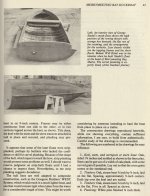
Some terms.....
Lines Plans These are the end result of lots of careful measuring and drawing. For many small craft, all the necessary information is presented on a single sheet.....
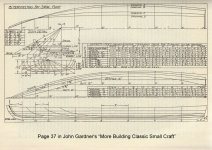
Construction Plans - But construction details are usually depicted on a separate sheet.
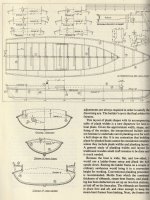
Taking the Lines - This is the painstaking process of measuring an existing vessel - paying strict attention to level, plumb and square - even when most of the shapes are curves. Howard Chapelle spent many years taking the lines off small craft of all kinds back in his day. (Another book I recommend to all!)
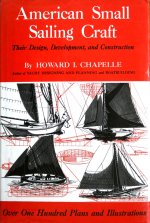
Here's a jig I made to help me take the lines off the TED SANFORD - a Great South Bay Scooter designed and built by Benjamin Hallock about 100 years ago.
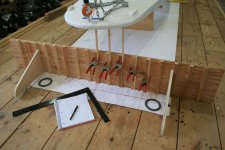
See the whole process - beginning around Gallery 13 - in my post about the TED SANFORD:
https://stevenjaysanford.com/great-south-bay-scooter/
Scantlings - These are the thickness and width of the pieces of lumber that go into a boat. Most gunning boats are built with "light scantlings" - many work boats are built to "heavy scantlings".
Sketch Plans - These are often not-to-scale conceptual drawings - either as the first step for sophisticated vessels - or as "the plans" for simpler craft. This sketch captures everything I needed to build SWEET GHERKIN.
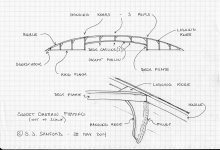
So, if any designer - professional or dedicated amateur - wanted to draw plans based on a few oblique photographs, he or she would need to set some "hard" parameters: LOA, beam, depth, deadrise, crown - and then make lots of decisions about the actual shapes. The traditional process of hull design began with carving a half-model (Below probably not suitable for most gunning waters....), taking the lines from it, then scaling up to full-size.
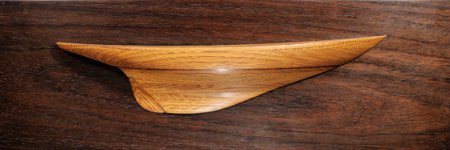
With the advent of plywood, small-scale cardboard of thin balsa models can suffice for simpler craft.
S- Dax et al - I hope this overview has been helpful!
SJS
Dax Hinton recently asked me how difficult it would be to draw plans to build an existing gunning boat - specifically the sweet "Midwest Gunning Skiffs" (my term) he found recently in a museum (?).
The short answer, I suppose, is very difficult. It is usually the province of trained and licensed marine architects. On the other hand, I have done it - and I imagine there are others here on the site that have done it as well. So, I will give an overview of the process and some random thoughts. I would encourage anyone to make the attempt.
I would also encourage anyone to read all of John Garner's books. This one has a lengthy chapter on Four Canoes - that would be a good starting point for anyone approaching this task. A beamier version of one of the 4 - to be decked over - may work for Dax.

The example I will use is a Merrymeeting Bay Duckboat. John begins with some photos of the vessel - from various viewpoints. Note that none of the photos depict the boat in true cross section (aka section), profile (aka elevations) or from directly above (plan view).

Some terms.....
Lines Plans These are the end result of lots of careful measuring and drawing. For many small craft, all the necessary information is presented on a single sheet.....

Construction Plans - But construction details are usually depicted on a separate sheet.

Taking the Lines - This is the painstaking process of measuring an existing vessel - paying strict attention to level, plumb and square - even when most of the shapes are curves. Howard Chapelle spent many years taking the lines off small craft of all kinds back in his day. (Another book I recommend to all!)

Here's a jig I made to help me take the lines off the TED SANFORD - a Great South Bay Scooter designed and built by Benjamin Hallock about 100 years ago.

See the whole process - beginning around Gallery 13 - in my post about the TED SANFORD:
https://stevenjaysanford.com/great-south-bay-scooter/
Scantlings - These are the thickness and width of the pieces of lumber that go into a boat. Most gunning boats are built with "light scantlings" - many work boats are built to "heavy scantlings".
Sketch Plans - These are often not-to-scale conceptual drawings - either as the first step for sophisticated vessels - or as "the plans" for simpler craft. This sketch captures everything I needed to build SWEET GHERKIN.

So, if any designer - professional or dedicated amateur - wanted to draw plans based on a few oblique photographs, he or she would need to set some "hard" parameters: LOA, beam, depth, deadrise, crown - and then make lots of decisions about the actual shapes. The traditional process of hull design began with carving a half-model (Below probably not suitable for most gunning waters....), taking the lines from it, then scaling up to full-size.

With the advent of plywood, small-scale cardboard of thin balsa models can suffice for simpler craft.
S- Dax et al - I hope this overview has been helpful!
SJS
Last edited:

